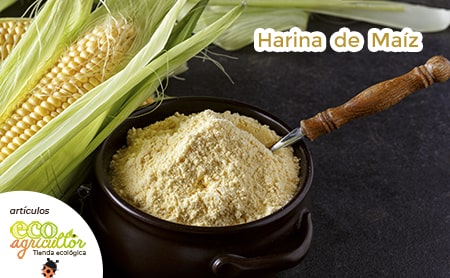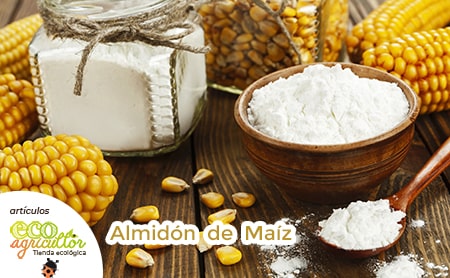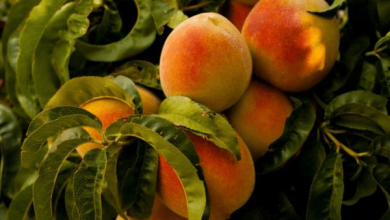Almidón de Maíz: ¿Qué es y para qué sirve? Cómo usarlo en Recetas y Diferencias con la Harina de Maíz

Corn is one of the most consumed foods in the world. This cereal is the main livelihood for millions of people around the world. In fact, more corn is produced than rice and wheat . And being gluten-free, it is appropriate for gluten-free diets.
We tell you what cornstarch is, what its nutritional value is, how it differs from cornmeal, uses in the kitchen and home remedies with cornstarch.
What is cornstarch?
Cornstarch is the main component of the corn kernel. It is a polysaccharide (a compound carbohydrate) made up of two glucose polymers (amylopectin and amylose) and is the food reserve of plants.
Corn, with the scientific name Zea mays , is also known by other names such as corn and corn . It is a plant native to Mexico and belongs to the botanical family of Grasses, such as Oats , Barley , Rye and Millet .
On the cob is where the corn grain grows, which is divided into three parts:
- Pericarp , it is the outermost layer (the shell or bran) that is hard and fibrous.
- Endosperm , is most of the grain. It serves as an energy reserve for the plant and is where the starch is found.
- Germ , the innermost layer made up mainly of lipids.
How are Corn Starch and Corn Flour different?
The difference between corn flour and cornstarch is that the flour is obtained by grinding the whole grain, while in the second case only a part of the grain is ground, the starch. This means that corn starch and corn flour have different nutritional value , despite the fact that starch constitutes approximately more than 80% of corn. Below I detail the nutrients in flour and starch.
Obtained from corn, cornstarch is gluten-free and is a very fine, white powder that is odorless and tasteless. Cornmeal, however, has a mild yellow hue and a mild flavor. Below you have pictures of the cornmeal and starch.
Perhaps cornstarch or cornstarch is the best known commercial brand of cornstarch.
The starch is also extracted from other cereals and tubers such as potatoes and cassava (tapioca). And by the way, depending on what food is obtained, in the case of tubers the definition of starch is used more and in the case of cereals the term starch is used mainly .
Nutritional Value of Corn Starch
For every 100 grams, we find:
- 374 kcal.
- 91.3 grams of carbohydrates, of which 09 are fiber
- 7.5 grams of water
- 0.26 grams of protein
- 0 grams of fat
Regarding the content of vitamins:
- 0.3 mg of Niacin or B3
And the minerals:
- 13 mg phosphorus
- 9 mg sodium
- 3 mg potassium
- 3 mg magnesium
- 2 mg calcium
- 0.47 iron
- 0.06 zinc
- 2.8 ug selenium
- 0.5 ug iodide

Nutritional value of Corn Flour
Yes, you can see nutritional differences between flour and cornstarch. We have just seen the nutritional value of starch and now I show you that of flour so that you can see in detail the differences between one and the other.
For every 100 grams of corn flour, we have:
- 329 Kcal.
- 66.3 grams are carbohydrates, of which 9.42 is fiber.
- 13.2 grams of water
- 8.29 grams of protein
- 2.82 grams of fat
And in the content of vitamins:
- 0.82 mg of Niacin or B3
- 0.45 mg of Vitamin E
- 0.44 mg of Thiamine or B1
- 0.13 mg of Riboflavin or B2
- 0.09 mg of Pyridoxine or B6
- 33 ug of Folates or B9
- 18 ug of Vitamin A
Regarding the mineral content:
- 120 mg potassium
- 69 mg phosphorus
- 47 mg magnesium
- 3 mg calcium
- 2.4 mg iron
- 1.6 mg zinc
- 0.7 mg sodium
- 1 ug of iodide
- 0.8 ug selenium
The vitamin content is higher and more varied in the case of flour, the mineral contribution is also higher, as well as that of fat and vegetable protein, while the levels of carbohydrates and calories are lower in flour.
To have the peace of mind of using a flour and a starch of the best quality, with a high content in nutrients but without the dangers of containing pesticide residues, choose Organic Corn Flour and Organic Corn Starch , for your Health.
What is Corn Starch Used for in Cooking?
It can be used alone or added to preparations in which flours are used and it is incorporated in both salty and sweet recipes, since it does not add flavor or smell and does not alter the final result of the dish in this sense.
Among the main uses of this food in the kitchen , we have:
- To thicken stews, sauces and soups.
- As a moisturizer.
- To extend the shelf life of bread and other preparations.
- To bind food.
- Give consistency to pastry preparations, such as ice cream, pastry cream, cookies and muffins.
- In batter and floured
To make a homogeneous mixture without lumps, first dissolve the cornstarch with a little water, broth, milk or vegetable drink (depending on the liquid you are using in the recipe) with a rod, spoon or fork and then Add to the pot to incorporate it to the rest of the ingredients.
Examples of Recipes with cornstarch :
- Lemon squares (sweet)
- Orange and coffee cookies (sweet)
- Potato omelette (salty)

9 Uses of Corn Starch Outside the Kitchen
But cornstarch is so versatile that it can be used beyond the kitchen.
For the following uses, you just need to mix starch with a little water to get a gel texture.
Some of the home remedies with cornstarch are:
- Remove ink stains from clothing
- Remove oil stains
- In case of chafing
- It can be an effective natural deodorant
- Soothe irritated skin and stings.
- Bring silver objects to shine.
- For oily skin
- Used dry, without mixing with water, it is useful as a dry shampoo against oily hair. A small amount is applied directly to the root. In addition, the cornstarch serves to detangle the hair, leaving it more manageable and loose. Put a small amount in the palm of your hand and rub into the hair. Afterwards he combs his hair as usual.
- Formerly, it was used to make shirt collars more rigid.
It is used as an input in the chemical industry.
In the pharmaceutical industry it is used as an excipient (the substance to which the active principles are added) in various medicines.
In the industrial field, it is used as an adhesive.
Corn is also used in the textile industry.
Corn starch and in general corn is a raw material of great value , being used for both human and animal food and, as we have seen, in all types of industries, from pharmaceuticals to paper mills through agronomy and textiles. It is even used to produce biodegradable plastics.
And you, what do you use cornstarch for?
Do you have a favorite recipe or dish that you want to share? Write us in the comments!
Consulted bibliography
https://www.bedca.net/
https://www.scielo.br/pdf/cta/v28n3/a31v28n3.pdf
http://dgsa.uaeh.edu.mx:8080/bibliotecadigital/bitstream/handle/231104/508/Caracterizacion%20morfologica%20y%20termica%20almidon%20de%20maiz.pdf;jsessionid=E63431FD9A1708833DB8C68631DC18A7?sence=1C68631DC18A7?

![Photo of Indoor Bonsai: [Characteristics, Varieties, Care and Irrigation]](https://www.complete-gardening.com/wp-content/uploads/2022/08/indoor-bonsai-characteristics-varieties-care-and-irrigation-390x220.jpg)
![Photo of Bach Flowers: [Examples, Care, Characteristics and Meaning]](https://www.complete-gardening.com/wp-content/uploads/2022/08/bach-flowers-examples-care-characteristics-and-meaning-390x220.jpg)

